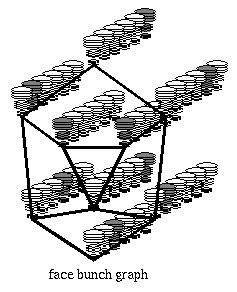While individual objects, such as faces, can be represented by simple labeled graphs, an object class requires a more comprehensive representation in order to account for all kind of variations within the class. Faces, for example, may have a beard or glasses, may have different expressions, or may be of different age, sex, or race. The Face Bunch Graph has a stack-like structure and combines graphs of individual sample faces. It is crucial that the individual graphs all have the same structure and that the nodes refer to the same fiducial points. All jets referring to the same fiducial point, e.g. all left-eye jets, are bundled together in a bunch, from which one can select any jet as an alternative description. The lef-eye bunch might contain a male eye, a female eye, both closed or open, etc. Each fiducial point is represented by such a set of alternatives and from each bunch any jet can be selected independently of the jets selected from the other bunches. That provides full combinatorial power of this representation and makes it so general even if constituted from few graphs only.

The figure shows a sketch of a face bunch graph. Each of the nine nodes is labeled with a bunch of six jets. From each bunch one particular jet has been selected, indicated as grey. The actual selection depends on the situation, e.g. the face onto which the face bunch graph is matched. Though constructed from six sample faces only, this bunch graph can potentially represent 6**9=10077696 different faces.
We use face bunch graphs for the localization of fiducial points in the Face Recognition project and for generating Phantom Faces for Face Analysis. The concept of the bunch graph is not restricted to faces but can be applied to any class of objects with a comparable standardization of structure.